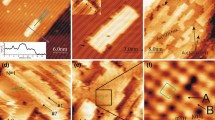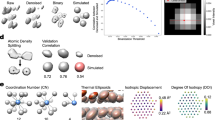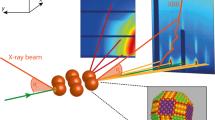Abstract
Understanding the adsorption mechanisms of large molecules on metal surfaces is a demanding task. Theoretical predictions are difficult because of the large number of atoms that have to be considered in the calculations, and experiments aiming to solve the molecule–substrate interaction geometry are almost impossible with standard laboratory techniques. Here, we show that the adsorption of complex organic molecules can induce perfectly ordered nanostructuring of metal surfaces. We use surface X-ray diffraction to investigate in detail the bonding geometry of C60 with the Pt(111) surface, and to elucidate the interaction mechanism leading to the restructuring of the Pt(111) surface. The chemical interaction between one monolayer of C60 molecules and the clean Pt(111) surface results in the formation of an ordered  reconstruction based on the creation of a surface vacancy lattice. The C60 molecules are located on top of the vacancies, and 12 covalent bonds are formed between the carbon atoms and the 6 platinum surface atoms around the vacancies. In-plane displacements induced on the platinum substrate are of the order of a few picometres in the top layer, and are undetectable in the deeper layers.
reconstruction based on the creation of a surface vacancy lattice. The C60 molecules are located on top of the vacancies, and 12 covalent bonds are formed between the carbon atoms and the 6 platinum surface atoms around the vacancies. In-plane displacements induced on the platinum substrate are of the order of a few picometres in the top layer, and are undetectable in the deeper layers.
This is a preview of subscription content, access via your institution
Access options
Subscribe to this journal
Receive 12 print issues and online access
$259.00 per year
only $21.58 per issue
Buy this article
- Purchase on Springer Link
- Instant access to full article PDF
Prices may be subject to local taxes which are calculated during checkout





Similar content being viewed by others
References
Joachim, C., Gimzewski, J. K. & Aviram, A. Electronics using hybrid-molecular and mono-molecular devices. Nature 408, 541–548 (2000).
Weckesser, J., Barth, J. V. & Kern, K. Direct observation of surface diffusion of large organic molecules at metal surfaces: PVBA on Pd(110). J. Chem. Phys. 110, 5351–5354 (1999).
Schunack, M. et al. Anchoring of organic molecules to a metal surface: HtBDC on Cu(110). Phys. Rev. Lett. 86, 456–459 (2001).
Rosei, F. et al. Organic molecules acting as templates on metal surfaces. Science 296, 328–331 (2002).
Rosei, F. et al. Properties of large organic molecules on metal surfaces. Prog. Surf. Sci. 71, 95–146 (2003).
Maxwell, A. J. et al. Scales in core level excitations: C 1s X-ray absorption of C60/Al. Phys. Rev. Lett. 79, 1567–1570 (1997).
Maxwell, A. J. et al. Electronic and geometric structure of C60 on Al(111) and Al(110). Phys. Rev. B 57, 7312–7326 (1998).
Pedio, M. et al. Study of C60/Au(110)-p(6 x 5) reconstruction from in-plane x-ray diffraction data. Phys. Rev. Lett. 85, 1040–1043 (2000).
Torrelles, X. et al. In-plane x-ray diffraction study of the C-60/Au(110) p(6x5) reconstructed surface by direct methods. Phys. Status Solidi b 215, 773–777 (1999).
Futaba, D. N. & Chiang, S. Calculation of scanning tunneling microscopy images of benzene on Pt(111) and Pd(111). Jpn J. Appl. Phys. 38, 3809–3812 (1999).
Hallmark, V. M., Chiang, S., Meinhardt, K. -P. & Hafner, K. Observation and calculation of internal structure in scanning-tunneling-microscopy images of related molecules. Phys. Rev. Lett. 70, 3740–3743 (1993).
Hallmark, V. M. & Chiang, S. Predicting STM images of molecular adsorbates. Surf. Sci. 329, 255–268 (1995).
Robinson, I. K. & Tweet, D. J. Surface X-ray diffraction. Rep. Prog. Phys. 55, 599–651 (1992).
Stengel, M., De Vita, A. & Baldereschi, A. Adatom-vacancy mechanisms for the C60/Al(111)-(6x6) reconstruction. Phys. Rev. Lett. 91, 166101 (2003).
Rudolf, P., Gensterblum, G. & Caudano, R. Growth and characterization of fullerene interfaces on metallic and semiconductor substrates. J. Phys. IV 7, 137–149 (1997).
Weckesser, J. et al. Binding and ordering of C60 on Pd(110): Investigations at the local and mesoscopic scale. J. Chem. Phys. 115, 9001–9009 (2001).
Needs, R. J., Godfrey, M. J. & Mansfield, M. Theory of surface stress and surface reconstruction. Surf. Sci. 242, 215–221 (1991).
Grübel, G. et al. Reconstruction of the Pt(111) surface – x-ray scattering measurements. Phys. Rev. B 48, 18119–18139 (1993).
Sandy, A. R., Mochrie, S. G. J., Zehner, D. M., Huang, K. G. & Gibbs, D. Structure and phases of the Au(111) surface: X-ray scattering measurements. Phys. Rev. B 43, 4667–4687 (1991).
Feibelman, P. J. First-principles calculations of stress induced by gas adsorption on Pt(111). Phys. Rev. B 56, 2175–2182 (1997).
Xu, H., Yuro, R. & Harrison, I. The structure and corrosion chemistry of bromine on Pt(111). Surf. Sci. 411, 303–315 (1998).
Mattsson, T. R. & Mattsson, A. E. Calculating the vacancy formation energy in metals: Pt, Pd, and Mo. Phys. Rev. B 66, 214110 (2002).
Pedio, M. et al. C60/metal surfaces: adsorption and decomposition. Surf. Sci. 437, 249–260 (1999).
Cepek, C., Goldoni, A. & Modesti, S. Chemisorption and fragmentation of C60 on Pt(111) and Ni(110). Phys. Rev. B 53, 7466–7472 (1996).
Vlieg, E. ROD: A program for surface X-ray crystallography. J. Appl. Crystallogr. 33, 401–405 (2000).
Robinson, I. K. Crystal truncation rods and surface roughness. Phys. Rev. B 33, 3830–3836 (1986).
Materer, N. et al. Reliability of detailed LEED structural analysis – Pt(111) and Pt(111)-p(2x2)-O. Surf. Sci. 325, 207–222 (1995).
Patterson, A. L. A Fourier series method for the determination of the components of interatomic distances in crystals. Phys. Rev. 46, 372–376 (1934).
Dyer, H. B. The crystal structure of cysteylglycine-sodium iodide. Acta Crystallogr. 4, 42–50 (1951).
Williams, G. J., Pfeifer, M. A., Vartanyants, I. A. & Robinson, I. K. Three-dimensional imaging of microstructure in Au nanocrystals. Phys. Rev. Lett. 90, 175501–175505 (2003).
Watson, G. W., Wells, R. P. K., Willock, D. J. & Hutchings, G. J. Density functional theory calculations on the interaction of ethane with the {111} surface of platinum. J. Phys. Chem. B 104, 6439–6446 (2000).
Gomes, J. R. B. & Gomes, J. A. N. F. Adsorption of the formyl species on transition metal surfaces. J. Electroanal. Chem. 483, 180–187 (2000).
Forro’, L. & Mihaly, L. Electronic properties of doped fullerenes. Rep. Prog. Phys. 64, 649–699 (2001).
Giovanelli, L. et al. Molecular orientation of C60 on Pt(111) determined by X-ray photo-electron diffraction. Appl. Surf. Sci. 212, 57–61 (2003).
Acknowledgements
We wish to acknowledge the ESRF staff for their technical help. This work was partially financed by MADESS II—CNR and FIRB—Carbon Nanotube and Carbide Surface projects.
Author information
Authors and Affiliations
Corresponding author
Ethics declarations
Competing interests
The authors declare no competing financial interests.
Rights and permissions
About this article
Cite this article
Felici, R., Pedio, M., Borgatti, F. et al. X-ray-diffraction characterization of Pt(111) surface nanopatterning induced by C60 adsorption. Nature Mater 4, 688–692 (2005). https://doi.org/10.1038/nmat1456
Received:
Revised:
Accepted:
Published:
Issue Date:
DOI: https://doi.org/10.1038/nmat1456
This article is cited by
-
Tuning conductance in C60 devices: defective C60 and endohedral C60 complex
Applied Physics A (2015)
-
Survey of structural and electronic properties of C60 on close-packed metal surfaces
Journal of Materials Science (2012)
-
Transforming C60 molecules into graphene quantum dots
Nature Nanotechnology (2011)
-
Fullerenes from aromatic precursors by surface-catalysed cyclodehydrogenation
Nature (2008)



